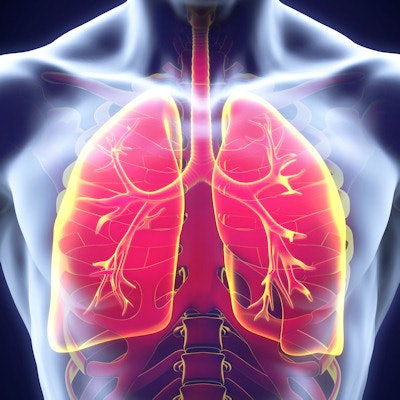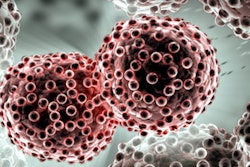
Researchers from the U.S. and China are developing a SPECT tracer that could improve the diagnosis and treatment of non-small cell lung cancer (NSCLC). The radiotracer targets a key receptor linked to the progression of NSCLC, according to a preclinical study published in the November issue of the Journal of Nuclear Medicine.
The tracer -- technetium-99m (Tc-99m) HYNIC-cMBP -- binds to the c-MET receptor, which is commonly found in NSCLC and promotes cancer growth. Thus far, Tc-99m-HYNIC-cMBP has been successful in targeting this receptor, with the tracer visible on SPECT images shortly after injection. The tracer also leaves the body within a few hours, reducing radiation exposure (JNM, November 2018, Vol. 59:11, pp. 1686-1691).
"c-Met is emerging as a promising therapeutic target for NSCLC, and methods for noninvasive in vivo assessment of c-Met expression would improve NSCLC treatment and diagnosis," wrote lead author Dr. Zhaoguo Han from Harbin Medical University in Heilongjiang, China, and colleagues.
NSCLC accounts for approximately 80% of lung cancer cases worldwide, and early detection of the disease is important for a better prognosis. Previous studies also have suggested that the c-Met receptor is a suitable target for treating NSCLC, and combination therapies attacking c-Met should be explored for possible use in the clinical setting.
The process of developing this tracer began with China Peptide, a Hangzhou, China-based provider of peptides for researchers and pharmaceutical companies, which synthesized and radiolabeled HYNIC-cMBP with technetium-99m. The tracer was then cultured in two NSCLC cell lines: H1993, which has high c-Met expression, and H1299, which has no c-Met expression.
The NSCLC cells were transplanted into mice, which were given 1.85 MBq of Tc-99m-HYNIC-cMBP to gauge tumor specificity in vivo via SPECT (Discovery 670H3100NA, GE Healthcare). Images were evaluated 30 minutes, one hour, two hours, and four hours after tracer injection.
The researchers observed a higher percentage of tracer accumulation in the H1993 tumors (4.74% ± 1.43% injected dose/g) than in the H1299 tumors (1.00% ± 0.37% injected dose/g). The difference reached statistical significance (p = 0.05). The H1993 tumors with high c-Met expression were clearly visible on SPECT at 30 minutes; on the other hand, the H1299 tumors, which had no c-Met expression, were not visible at any time after tracer administration.
In addition, the Tc-99m-HYNIC-cMBP tracer cleared from the NSCLC tumors within two to four hours. That quick pace helps reduce radiation exposure, background noise, and delays between treatment and imaging readout, according to the authors.
While the preliminary findings are encouraging, the group noted that more research is needed. For example, the 30-minute time frame for optimal SPECT images "may not allow sufficient time for preparation, and it may be preferable to extend this imaging time to approximately one hour, as is the case for FDG," the authors wrote.



















